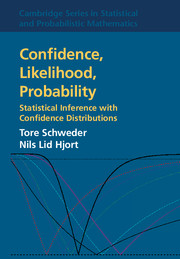Book contents
- Frontmatter
- Dedication
- Contents
- Preface
- 1 Confidence, likelihood, probability: An invitation
- 2 Inference in parametric models
- 3 Confidence distributions
- 4 Further developments for confidence distribution
- 5 Invariance, sufficiency and optimality for confidence distributions
- 6 The fiducial argument
- 7 Improved approximations for confidence distributions
- 8 Exponential families and generalised linear models
- 9 Confidence distributions in higher dimensions
- 10 Likelihoods and confidence likelihoods
- 11 Confidence in non- and semiparametric models
- 12 Predictions and confidence
- 13 Meta-analysis and combination of information
- 14 Applications
- 15 Finale: Summary, and a look into the future
- Overview of examples and data
- Appendix: Large-sample theory with applications
- References
- Name index
- Subject index
6 - The fiducial argument
Published online by Cambridge University Press: 05 March 2016
- Frontmatter
- Dedication
- Contents
- Preface
- 1 Confidence, likelihood, probability: An invitation
- 2 Inference in parametric models
- 3 Confidence distributions
- 4 Further developments for confidence distribution
- 5 Invariance, sufficiency and optimality for confidence distributions
- 6 The fiducial argument
- 7 Improved approximations for confidence distributions
- 8 Exponential families and generalised linear models
- 9 Confidence distributions in higher dimensions
- 10 Likelihoods and confidence likelihoods
- 11 Confidence in non- and semiparametric models
- 12 Predictions and confidence
- 13 Meta-analysis and combination of information
- 14 Applications
- 15 Finale: Summary, and a look into the future
- Overview of examples and data
- Appendix: Large-sample theory with applications
- References
- Name index
- Subject index
Summary
To obtain a distribution representing the inferred uncertain knowledge about the parameter directly from the data without access to any prior distribution was the glorious goal that Fisher succeeded in reaching with his fiducial distribution for a scalar parameter, but for vector parameters he got into trouble. He regarded the fiducial distribution as an ordinary probability distribution subject to the usual Kolmogorovian laws for sigma-additive probability measures. Fisher did not develop any mathematical theory of fiducial probability, but chose to illustrate his thoughts by examples. It was soon found that even in Fisher's examples with more than one parameter, there were no unique fiducial distributions, and inconsistencies and paradoxes were identified. After re-visiting Fisher's ideas over 1930–1935, which underlie our confidence distributions, we summarise and discuss the big debate over the fiducial argument, which died out only after Fisher's death in 1962, leaving the statistical community to regard it as badly flawed and Fisher's biggest blunder. The chapter ends with three attempts at saving the fiducial argument. Despite the potential problems with multivariate fiducial distributions, their marginals are often exact or approximate confidence distributions.
The initial argument
Fisher introduced the fiducial argument in 1930. In the introduction to Fisher (1930) he indicates that he had solved a very important problem that had escaped “the most eminent men of their time” since Bayes introduced his theorem and the method of inverse probability was established by Laplace. Later he stated that he really had a solution to “more than 150 years of disputation between the pros and cons of inverse probability [that] had left the subject only more befogged by doubt and frustration” (Fisher discussing Neyman in Neyman [1934, p. 617]). This was a view he held throughout his life.
Fisher saw the fiducial probability as a probability measure over the parameter inherited from the probability model of the sampling experiment and the observed data. His early interpretation of fiducial probability was very similar to Neyman's coverage probability for intervals. Later he thought of fiducial distributions as a representation of the information in the data as seen on the background of the statistical model. It would then serve as an epistemic probability distribution for rational people. This is close to the Bayesian understanding of a posterior distribution, at least for people agreeing on the prior distribution.
- Type
- Chapter
- Information
- Confidence, Likelihood, ProbabilityStatistical Inference with Confidence Distributions, pp. 185 - 203Publisher: Cambridge University PressPrint publication year: 2016



